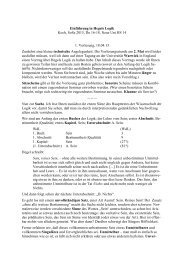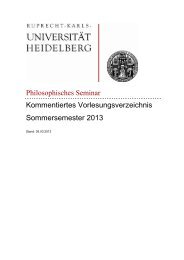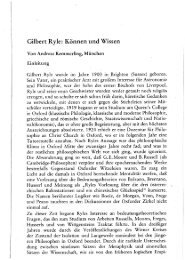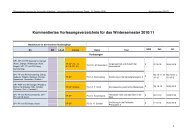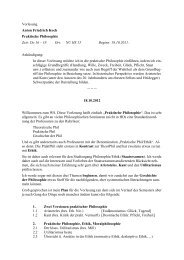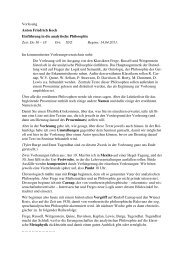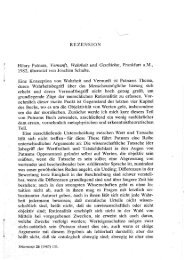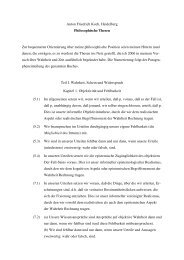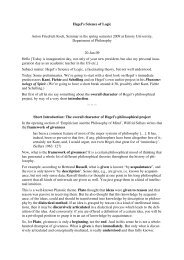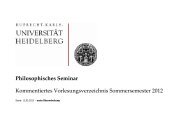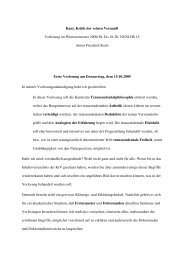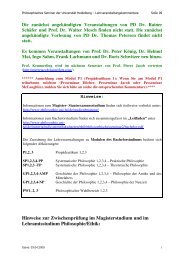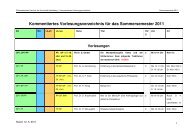KANT'S CRITIQUE OF TELEOLOGY IN BIOLOGICAL EXPLANATION
KANT'S CRITIQUE OF TELEOLOGY IN BIOLOGICAL EXPLANATION
KANT'S CRITIQUE OF TELEOLOGY IN BIOLOGICAL EXPLANATION
Create successful ePaper yourself
Turn your PDF publications into a flip-book with our unique Google optimized e-Paper software.
12 Theory of the Organism<br />
that this activity of God was unique and occurred only at the<br />
creation of matter. After the creation only the laws of matter in<br />
motion hold. God was thus thought to play a part in cosmogony but<br />
not in physics. Robert Boyle in particular expressed this view again<br />
and again: 6<br />
I think also further, that the wise Author of things did, by establishing the<br />
laws of motion among bodies, and by guiding the first motions of the small<br />
parts of matter, bring them to convene after the manner requisite to compose<br />
the world, and especially did contrive those curious and elaborate engines,<br />
the bodies of living creatures, endowing most of them with a power of<br />
propagating their species.<br />
In such remarks the true sense of the term "preformation"<br />
becomes clear: the organizational forms of all species of organism<br />
are determined at the creation of the world. All species were preformed<br />
by the divine watchmaker. The task of a theory of generation<br />
and heredity was thus to explain the nature of this "power of propagating<br />
their species" as well as to reveal the material means of<br />
guaranteeing its continuity and constancy over time. The solution<br />
that was to prevail for almost a century arose in the 1670's more or<br />
less simultaneously in the work of a number of philosophers and<br />
physicians. This solution consisted in assuming that all the germs<br />
of all the individuals that were ever to live were created in a single<br />
act of creation. According to this kind of explanation the miniature<br />
copies of the future organisms have existed fully formed in the<br />
germs since creation. There were then three different theorems<br />
about how the germs had been stored since that time: panspermism<br />
and two kinds of encasement, ovism and animalculism. 7 Pan-<br />
6 Boyle, "Forms and Qualities," p. 15; cf. also p. 48: "I do not at all believe that<br />
either these Cartesian laws of motion, or the Epicurean casual concourse of atoms,<br />
could bring mere matter into so orderly and well contrived a fabrick as this<br />
world; and therefore I think, that the wise Author of nature did not only put matter<br />
into motion, but, when he resolved to make the world, did so regulate and guide the<br />
motions of the small parts of the universal matter, as to reduce the greater systems<br />
of them into the order they were to continue in; and did more particularly contrive<br />
some portions of that matter into seminal rudiments or principles, lodged in convenient<br />
receptacles (and as it were wombs) and others into the bodies of plants and<br />
animals ..."<br />
7 Descartes' follower Pierre Silvain Regis described the possibilities in his<br />
Cours de Philosophie (first published in 1690, but completed perhaps as early as<br />
1681) II,641: "Those who believe that the germs were produced at the beginning of<br />
the world are not all in agreement about the place in which they were formed:<br />
some believe that they were formed in the womb of the first Female of each species;<br />
others maintain that they were formed in the testicles of the first male; and there



